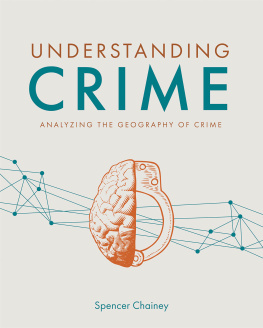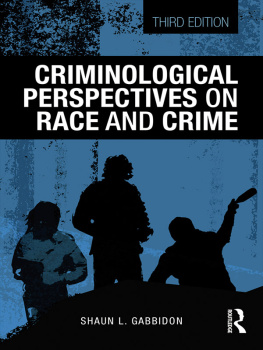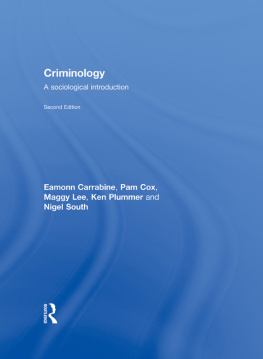
Patterns, Prevention, and
Geometry of Crime
P. and P. Brantingham's enormous contribution to criminology has paved the way for major theoretical and empirical developments in the understanding of crime and its respective patterns, prevention, and geometry. In this unique collection of original essays, Andresen and Kinney bring together leading scholars in the field of environmental criminology to honour the work of P&P Brantingham with new research on the geometry of crime, patterns in crime and crime generators and attractors.
Chapters include new perspectives on the crime mobility triangle, electronic monitoring, illegal drug markets, the patterns of vehicle theft for export, prolific offender patterns, crime rates in hotels and motels, violent crime and juvenile crime. A final chapter gathers together a collection of letters to P&P Brantingham, from key scholars reflecting on and celebrating their important contribution.
This volume provides essential readings for those interested in the field of environmental criminology.
Martin A. Andresen is Assistant Professor at Simon Fraser University School of Criminology and Institute for Canadian Urban Research Studies. His research areas include: spatial statistical analysis, crime at places, and co-offending with recent research published in Annals of the Association of American Geographers, British Journal of Criminology, Environment and Planning A, European Journal of Criminology, European Sociological Review, and Journal of Research in Crime and Delinquency.
J. Bryan Kinney is the Director of the Institute for Canadian Urban Research Studies (ICURS) Laboratory. In 2005 he received his PhD (Criminology) at Simon Fraser and joined the faculty of the School of Criminology in that same year, where he teaches graduate and undergraduate courses on environmental criminology, crime prevention, and crime analysis. Dr. Kinney's publications include work on crime and place, offender mobility, target selection and crime pattern analysis, and have appeared in The Built Environment, Crime Patterns and Analysis, and Security Journal. Beyond his continued interest in environmental criminology, his research interests include interdisciplinary projects involving computational criminology and criminal justice systems modeling.
Crime Science Series
Edited by Richard Wortley, UCL
Crime science is a new way of thinking about and responding to the problem of crime in society. The distinctive nature of crime science is captured in the name.
First, crime science is about crime. Instead of the usual focus in criminology on the characteristics of the criminal offender, crime science is concerned with the characteristics of the criminal event. The analysis shifts from the distant causes of criminality biological makeup, upbringing, social disadvantage and the like to the near causes of crime. Crime scientists are interested in why, where, when and how particular crimes occur. They examine trends and patterns in crime in order to devise immediate and practical strategies to disrupt these patterns.
Second, crime science is about science. Many traditional responses to crime control are unsystematic, reactive, and populist, too often based on untested assumptions about what works. In contrast crime science advocates an evidencebased, problem-solving approach to crime control. Adopting the scientific method, crime scientists collect data on crime, generate hypotheses about observed crime trends, devise interventions to respond to crime problems, and test the adequacy of those interventions.
Crime science is utilitarian in its orientation and multidisciplinary in its foundations. Crime scientists actively engage with front-line criminal justice practitioners to reduce crime by making it more difficult for individuals to offend, and making it more likely that they will be detected if they do offend. To achieve these objectives, crime science draws on disciplines from both the social and physical sciences, including criminology, sociology, psychology, geography, economics, architecture, industrial design, epidemiology, computer science, mathematics, engineering, and biology.
Superhighway Robbery
Graeme R. Newman,
Ronald V. Clarke
Crime Reduction and Problemoriented
Policing
Edited by Karen Bullock and
Nick Tilley
Crime Science
New approaches to preventing and
detecting crime
Edited by Melissa J. Smith and
Nick Tilley
Problem-oriented Policing and
Partnerships
Implementing an evidence-based
approach to crime reduction
Karen Bullock, Rosie Erol and
Nick Tilley
Preventing Child Sexual Abuse
Stephen Smallbone,
William L. Marshall and
Richard Wortley
Environmental Criminology and
Crime Analysis
Edited by Richard Wortley and
Lorraine Mazerolle
Raising the Bar
Preventing aggression in and around
bars, pubs and clubs
Kathryn Graham and Ross Homel
Situational Prevention of
Organised Crimes
Edited by Karen Bullock,
Ronald V. Clarke and Nick Tilley
Psychological Criminology
An integrative approach
Richard Wortley
The Reasoning Criminologist
Essays in honour of
Ronald V. Clarke
Edited by Nick Tilley and
Graham Farrelll
Patterns, Prevention and
Geometry of Crime
Edited by Martin A. Andresen and
J. Bryan Kinney
Patterns, prevention, and
geometry of crime
Edited by Martin A. Andresen
and J. Bryan Kinney
First published 2012
by Routledge
2 Park Square, Milton Park, Abingdon, Oxon, OX14 4RN
Simultaneously published in the USA and Canada
by Routledge
711 Third Avenue, New York, NY 10017
Routledge is an imprint of the Taylor & Francis Group
2012 Martin A. Andresen and J. Bryan Kinney; individual chapters,
the contributors
The right of Martin A. Andresen and J. Bryan Kinney to be identified as the editors of this work has been asserted by them in accordance with sections 77 and 78 of the Copyright, Designs and Patents Act 1988.
All rights reserved. No part of this book may be reprinted or reproduced or utilised in any form or by any electronic, mechanical, or other means, now known or hereafter invented, including photocopying and recording, or in any information storage or retrieval system, without permission in writing from the publishers.
Trademark notice: Product or corporate names may be trademarks or registered trademarks, and are used only for identification and explanation without intent to infringe.
British Library Cataloguing in Publication Data
A catalogue record for this book is available from the British Library
Library of Congress Cataloging-in-Publication Data
A catalog record has been requested for this book
ISBN: 978-0-415-68587-0 (hbk)
ISBN: 978-0-203-14194-6 (ebk)
Typeset in Times New Roman by GCS, Leighton Buzzard, Bedfordshire
This collection of essays is in honour of
P. and P. Brantingham
Contents
Preface
MARTIN A. ANDRESEN AND J. BRYAN KINNEY
1 Editors introduction: Patterns, prevention, and geometry of crime







